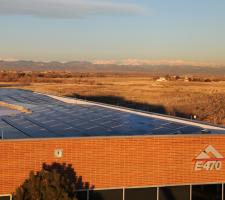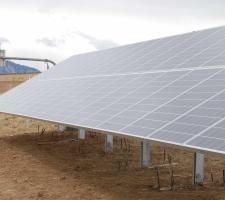
Custom TOP-mounted arrays along the E 56th Avenue section of the E-470
RSSDavid Crawford reports on energy cost cutting on US highways
Just over a year after switch-on and with two global awards under its belt, the longest solar-powered toll road in the US is generating heightened interest in highway applications of alternative energy. The E-407, which loops around the eastern perimeter of the Denver metropolitan area in Colorado, won the International Bridge, Tunnel and Turnpike Association (63 IBTTA) President’s Overall Award for Excellence at its September 2013 Annual Meeting in Vancouver, Canada.
One of two solar-powered tollways in the State (see below), it emerged triumphant from a shortlist of four earlier-announced toll excellence category winners, having come top in the Social Responsibility class. Commented IBTTA executive director and CEO Pat Jones: “This year’s submissions were particularly innovative.”
The project which has a maximum generating capacity of 707.3kW, has been operational since June 2012 and comprises a portfolio of 22 installations along a 27km north-south section of E-470 in Aurora, running south from Denver International Airport. It is run by the E-470 Public Highway Authority, a political grouping of three county and five municipal administrations.
Much of its expenditure is taken up by ongoing road maintenance. But another major portion cost is the electricity needed to power its administrative HQ and control centre, maintenance depot, monitoring stations, toll plaza equipment, streetlighting and variable message signs.
A cashless toll road since 2009, E-470 has energy-consuming installations at roughly 400 metres intervals along the route and at on and off ramps, the resulting data being coordinated at the control centre. Looking to reduce its operational costs, the authority decided to explore the scope for a solar photovoltaic system, taking advantage of Colorado’s fast-growing presence in the industry.
The State ranks as a solar hot spot with the city of Boulder, lying 50km north-west of Denver, scoring 5.5 equivalent noontime sun hours per day annual average. E-470 solar programme manager Walt Arnason told ITS International: “We had three primary objectives: to combat rapidly rising energy costs, reduce our environmental impact and to achieve these with minimal financial investment.”
Having evaluated options for carrying out a project itself, or purchasing a turnkey system, the authority decided to enter into a contract with New York-based Adamas Energy Investments, which offered a power purchase funding agreement. Adamas has paid the entire US$2.8 million cost of equipping and implementing the system, which it owns.
It sells the power generated to the E-470 Highway Authority under a 20-year power purchase agreement. The US arm of Portuguese group Martifer Solar’s took charge of engineering, procurement and construction and is responsible for maintenance.
Currently the system delivers some 47% of E-470’s overall power needs and is linked to the power grid of local energy operator Xcel Energy, which ‘net-meters’ the output. Net metering allows E-470 to bank, with Xcel Energy, solar-generated power that is in excess of its immediate needs; and to draw on that bank in the winter, when the days are shorter and there is less sunlight to generate power.
E-470 has a locked-in fixed energy cost rate with Adamas for the first six years, followed by a fixed annual increase for another 14. It anticipated paying Adamas less per kWh than was previously the case when buying solely from a utility company and, says Arnason: “that has proven to be the case.
“In the first year of operation, we have saved approximately US$20,000 and this is on track to grow by 50% in the current year. As energy costs rise, we project that the stable, 20-year fixed-pricing we will have in place will save us US$1 million.”
Over the same timeframe, E-470 expects to avoid emitting 24,000 tonnes of CO2 emissions from the imported oil that conventional electricity generation would produce. The project has also exceeded its initial target of producing an annual 975,436 kWh output by delivering more than one million kWh in the first year of operation.
The largest individual array serves the maintenance depot in Aurora, where it offsets 12.4% of the power costs. Others lie at 21 sites along the route where they offset 91% of usage.
“Ultimately,” says Arnason, “our goal is to have solar installations in place along our entire route.” E-470 is having preliminary discussions with United Power, a local not-for-profit customer-owned provider, which supplies another 33.5km of route. Martifer, which assessed the US potential on the basis of European experience, is looking for further highway solar projects and has also been involved in E-470 second-phase evaluations.
Adamas managing partner Richard Dovere told1846 ITS International: “This is a first for us in the transportation sector but this is an area in which we are increasingly active. We are currently involved in the development and financing of a number of similar projects with governmental and commercial partners in the US”.
Maya Rao, head of communications with Martifer US, added: “The main challenges have been that the spread-out arrays have 22 individual metering and interconnection points; and that we had our crew working alongside an active, high-speed transportation corridor. We had to make sure to conform to all state, local and transportation regulations for safety and road work.”
Another issue was the mounting of the solar arrays. For most of these Martifer designed a variant of the ‘top of pole’ solution typically deployed for domestic systems in order to lift the panels above ground-related hazards. Their fabrication incorporates helical piers which were designed by Denver-based EV Studio.
These are steel shafts, typically square, terminating in large screws. Used as deep foundation supports in challenging terrain, they transfer the load of a structure through unsuitable soil to a stronger and more appropriate base lying deeper in the earth.
The company’s director of structural engineering, Jim Houlette, told ITS International: “While pile-driven posts are faster and cost effective, helical piers may be needed in poor soil conditions. They also provide higher downward and uplift capacities.
“Those along E-470, where the open topography increases exposure, have to cope with higher snow and wind loads than they would in other locations.”
The total investment amounts to some US$350,000 and was 100% funded by Denver-based Soltura Energy Capital using renewable energy incentive programmes and credits - tradable environmental commodities confirming generation from an eligible resource. Northwest Parkway has signed a 20-year power purchase agreement to buy the energy generated, at the end of which it expects the rate it pays to be lower than today’s applicable equivalent. System installer is Bella Energy.
The completed project delivers just over 11% of Northwest Parkway’s needs, powering under-deck bridge lights, roadside and overhead signs, as well as tolled ramps via net metering with Xcel Energy. The arrays are mounted on racking systems supplied by the US operation of German company Schletter.
Designed to generate an average of 62kWh per day, the system has achieved just over 99kWh in its latest full year of operation. Northwest Parkway expects to save US$164,000 over the term of the agreement, as well as 2,540 tonnes of CO2.
CEO Pedro Costa told ITS International: “We plan to expand our programme if United Power can offer incentives.” It fits, he says, within the sustainability goals of Portugal-headquartered tollroad operator2051 BRISA Auto-Estradas, which runs the road under a 99-year concession from the Northwest Parkway Public Highway Authority and also has operations elsewhere in Europe and India.
Sebastian de Atucha, a partner in Soltura, which previously focussed on lighting efficiency retrofits, told ITS International: “This was our first tollway deployment and we would certainly do more if the conditions were right. In some cases we had to compromise on energy production because the slope of the site was not favourable for a good south-facing PV system; so, we had to orient off due south by some degrees.
“Ground erosion on steeply-sloped areas was something that the installation team was not really used to and they had to carry out more restoration than is typical for solar. We are in our third year of production and the system has exceeded our production estimates by 10%.” RSS
Just over a year after switch-on and with two global awards under its belt, the longest solar-powered toll road in the US is generating heightened interest in highway applications of alternative energy. The E-407, which loops around the eastern perimeter of the Denver metropolitan area in Colorado, won the International Bridge, Tunnel and Turnpike Association (
One of two solar-powered tollways in the State (see below), it emerged triumphant from a shortlist of four earlier-announced toll excellence category winners, having come top in the Social Responsibility class. Commented IBTTA executive director and CEO Pat Jones: “This year’s submissions were particularly innovative.”
The project which has a maximum generating capacity of 707.3kW, has been operational since June 2012 and comprises a portfolio of 22 installations along a 27km north-south section of E-470 in Aurora, running south from Denver International Airport. It is run by the E-470 Public Highway Authority, a political grouping of three county and five municipal administrations.
Much of its expenditure is taken up by ongoing road maintenance. But another major portion cost is the electricity needed to power its administrative HQ and control centre, maintenance depot, monitoring stations, toll plaza equipment, streetlighting and variable message signs.
A cashless toll road since 2009, E-470 has energy-consuming installations at roughly 400 metres intervals along the route and at on and off ramps, the resulting data being coordinated at the control centre. Looking to reduce its operational costs, the authority decided to explore the scope for a solar photovoltaic system, taking advantage of Colorado’s fast-growing presence in the industry.
The State ranks as a solar hot spot with the city of Boulder, lying 50km north-west of Denver, scoring 5.5 equivalent noontime sun hours per day annual average. E-470 solar programme manager Walt Arnason told ITS International: “We had three primary objectives: to combat rapidly rising energy costs, reduce our environmental impact and to achieve these with minimal financial investment.”
Having evaluated options for carrying out a project itself, or purchasing a turnkey system, the authority decided to enter into a contract with New York-based Adamas Energy Investments, which offered a power purchase funding agreement. Adamas has paid the entire US$2.8 million cost of equipping and implementing the system, which it owns.
It sells the power generated to the E-470 Highway Authority under a 20-year power purchase agreement. The US arm of Portuguese group Martifer Solar’s took charge of engineering, procurement and construction and is responsible for maintenance.
Currently the system delivers some 47% of E-470’s overall power needs and is linked to the power grid of local energy operator Xcel Energy, which ‘net-meters’ the output. Net metering allows E-470 to bank, with Xcel Energy, solar-generated power that is in excess of its immediate needs; and to draw on that bank in the winter, when the days are shorter and there is less sunlight to generate power.
E-470 has a locked-in fixed energy cost rate with Adamas for the first six years, followed by a fixed annual increase for another 14. It anticipated paying Adamas less per kWh than was previously the case when buying solely from a utility company and, says Arnason: “that has proven to be the case.
“In the first year of operation, we have saved approximately US$20,000 and this is on track to grow by 50% in the current year. As energy costs rise, we project that the stable, 20-year fixed-pricing we will have in place will save us US$1 million.”
Over the same timeframe, E-470 expects to avoid emitting 24,000 tonnes of CO2 emissions from the imported oil that conventional electricity generation would produce. The project has also exceeded its initial target of producing an annual 975,436 kWh output by delivering more than one million kWh in the first year of operation.
The largest individual array serves the maintenance depot in Aurora, where it offsets 12.4% of the power costs. Others lie at 21 sites along the route where they offset 91% of usage.
“Ultimately,” says Arnason, “our goal is to have solar installations in place along our entire route.” E-470 is having preliminary discussions with United Power, a local not-for-profit customer-owned provider, which supplies another 33.5km of route. Martifer, which assessed the US potential on the basis of European experience, is looking for further highway solar projects and has also been involved in E-470 second-phase evaluations.
Adamas managing partner Richard Dovere told
Maya Rao, head of communications with Martifer US, added: “The main challenges have been that the spread-out arrays have 22 individual metering and interconnection points; and that we had our crew working alongside an active, high-speed transportation corridor. We had to make sure to conform to all state, local and transportation regulations for safety and road work.”
Another issue was the mounting of the solar arrays. For most of these Martifer designed a variant of the ‘top of pole’ solution typically deployed for domestic systems in order to lift the panels above ground-related hazards. Their fabrication incorporates helical piers which were designed by Denver-based EV Studio.
These are steel shafts, typically square, terminating in large screws. Used as deep foundation supports in challenging terrain, they transfer the load of a structure through unsuitable soil to a stronger and more appropriate base lying deeper in the earth.
The company’s director of structural engineering, Jim Houlette, told ITS International: “While pile-driven posts are faster and cost effective, helical piers may be needed in poor soil conditions. They also provide higher downward and uplift capacities.
“Those along E-470, where the open topography increases exposure, have to cope with higher snow and wind loads than they would in other locations.”
Northwest Parkway
Connecting with E-470 at Interstate Highway 25, the Northwest Parkway began operating its solar system a year earlier, in June 2011. The project deploys seven individual arrays in right-of-way space along a one-third section of Northwest Parkway’s 13km length where the utility supply is by Xcel Energy (United Power supplied the electricity for the other section).The total investment amounts to some US$350,000 and was 100% funded by Denver-based Soltura Energy Capital using renewable energy incentive programmes and credits - tradable environmental commodities confirming generation from an eligible resource. Northwest Parkway has signed a 20-year power purchase agreement to buy the energy generated, at the end of which it expects the rate it pays to be lower than today’s applicable equivalent. System installer is Bella Energy.
The completed project delivers just over 11% of Northwest Parkway’s needs, powering under-deck bridge lights, roadside and overhead signs, as well as tolled ramps via net metering with Xcel Energy. The arrays are mounted on racking systems supplied by the US operation of German company Schletter.
Designed to generate an average of 62kWh per day, the system has achieved just over 99kWh in its latest full year of operation. Northwest Parkway expects to save US$164,000 over the term of the agreement, as well as 2,540 tonnes of CO2.
CEO Pedro Costa told ITS International: “We plan to expand our programme if United Power can offer incentives.” It fits, he says, within the sustainability goals of Portugal-headquartered tollroad operator
Sebastian de Atucha, a partner in Soltura, which previously focussed on lighting efficiency retrofits, told ITS International: “This was our first tollway deployment and we would certainly do more if the conditions were right. In some cases we had to compromise on energy production because the slope of the site was not favourable for a good south-facing PV system; so, we had to orient off due south by some degrees.
“Ground erosion on steeply-sloped areas was something that the installation team was not really used to and they had to carry out more restoration than is typical for solar. We are in our third year of production and the system has exceeded our production estimates by 10%.” RSS














